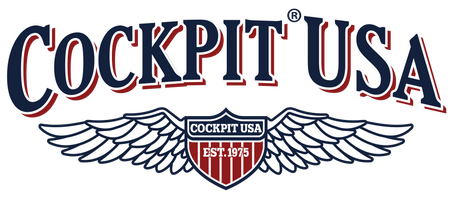100 Years of The British Royal Air Force
Today on this 100th anniversary of Great Britain’s Royal Air Force Cockpit USA commemorates the bravery and history our country’s strongest ally in Europe. Our RAF sheepskin bomber jacket represents the epitome of English heroism during WWII. Worn over London skies in the summer of 1940 by English fighter pilots flying Spitfire and Hurricane fighters in air battles against Nazi air forces, this bomber jacket provided the warmth and freedom of movement needed during combat.

Pilots in the RAF tailored their jackets to shear down the wool to allow more freedom of movement. We at Cockpit USA have introduced a short sheared sheepskin version light enough to wear with a sweater or other layering pieces. We also commemorate the efforts of the RAF by showcasing a beautiful R.A.F belt buckle inspired by the British crown insignia. On this anniversary Cockpit USA introduces our new "RAF Eagle Squadron Tee" which pays respect to the three fighter squadrons of the Royal Air Force formed with volunteer pilots from the United States. We honor the achievements of one of the most important military units ever assembled and focus on the its development by looking back at its early years of service during WWI and WWII.

The British Royal Air Force was formed on April 1, 1918 as an integration of the Royal Flying Corps (RFC) and the Royal Naval Air Service (RNAS). The development of British flight engineering began years later after the American brothers Wilbur and Orville Wright made the fist ever flight of self-propelled heavier than air aircraft flight in 1903. This gave birth to the Royal Naval Flying School at Eastchurch, Kent on December 1911. The school was eventually integrated into the Royal Flying Corps forming a new airplane squadron. Soon after, the specifications of the navy introduced the RNAS.



On August 4th 1914 Britain declared war on Germany and entered WWI. The British RFC only had 84 aircraft while the RNAS had 71. Germany’s advance technologies gave it great advantage during air strikes, which crippled towns in England through damaging bombings. This disadvantage caused the British military to create a separate ministry, which could focus on the development of strategic air bombing against Germany.

It was on April 1st, 1918 that the RAF was born incorporating a female group called the Women’s Royal Air Force. The WRAF came forth after the concern of the loss of specialized female workforce. The WRAF fell into two categories; one fell under “immobiles” as they stayed attached to their local station. The second category being “mobile” lived in quarters on or near the workplace and could be transferred elsewhere if needed. The WRAF held the reputation of becoming the most professional and disciplined of all women’s service due to the strict guidelines imposed by the RAF. The WRAF came to and end on August 1919 and became an individual asset to the RAF as a whole, their bravery and call to action to a country in need held these women as one of the most important service groups during WWI. By the end of the first World War on November 11,1918, the RAF had dropped 5,500 tons of bombs and claimed 2,953 enemy aircraft destroyed, gaining clear air superiority along the Western Front and contributing to the Allied victory over Germany and the other Central Powers. It had also become the largest air force in the world at the time, with some 300,000 officers and airmen—plus 25,000 members of the WRAF—and more than 22,000 aircraft. The RAF expanded quickly due to the outbreak of the Second World War. The men of the regular pre-war air force were joined by those from the Royal Auxiliary Air Force, formed in 1924 to provide a reserve of manpower, and the RAF Volunteer Reserve (RAFVR), who were put on the active list when war was imminent and who were vital to the RAF's performance, particularly during the Battle of Britain. During the Second World War the RAF fought in every major theatre, the Battle of Britain being the most famous campaign where Britain fought the superior German Air Forces, blocked the Luftwaffe air supremacy over southern England and therefore preventing the German invasion of England.
Photo of French Pilot flying with original RAF Jacket. Click here for Cockpit USA's RAF Sheepskin Bomber Jacket
The rapid expansion of the RAF came to life after the absorption of the men and planes of the air forces of the British Dominions of Canada, Australia, New Zealand, and South Africa. This also included European countries in exile fighting against the Nazis such as Poland, Czech Republic, France, and Belgium as well as British Indian colonials and British West Indian recruits. During World War II the RAF reached a total power of 1.2 million men and women, of whom 185,000 were aircrew. Unfortunately about 70 thousand personnel were killed. The British Royal Air Force will forever be known as one of the most significant professional groups ever assembled and a true ally to the United States of America.







